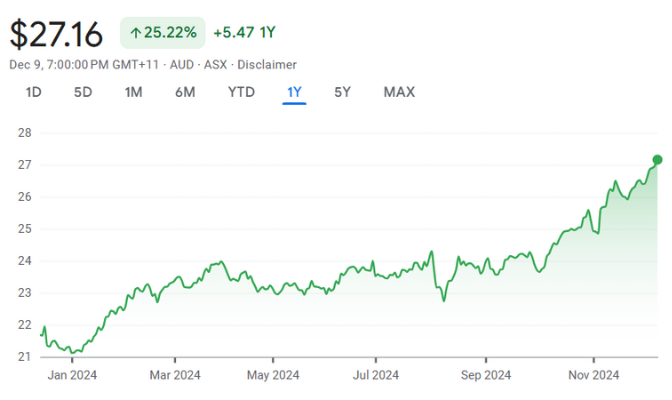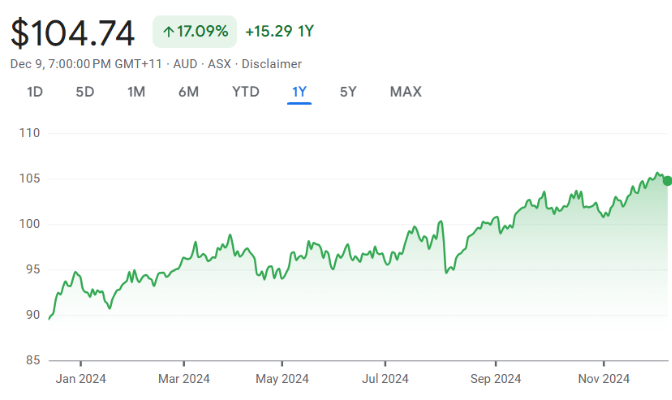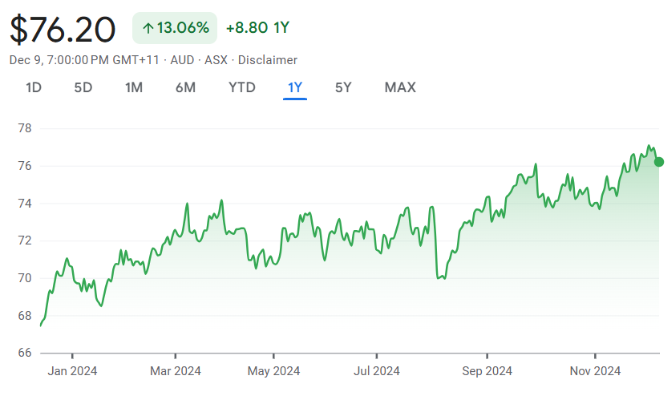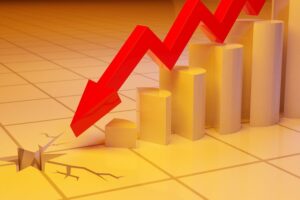What Is a Dividend ETF?
A dividend ETF is a type of pooled investment vehicle designed to provide investors with exposure to a diversified basket of dividend-paying stocks. When you invest in a dividend ETF, you own units of the ETF, which in turn owns the underlying shares of various companies that regularly pay dividends.
These ETFs are traded on the Australian Securities Exchange (ASX), making them easily accessible and liquid. They offer a convenient way to diversify your portfolio and enjoy a steady stream of income. They're also particularly appealing to investors looking for passive income without the need to manage individual stock investments actively so by focusing on dividend-paying investments, dividend ETFs help you achieve both income and growth goals.
How Dividend ETFs Work
Dividend ETFs operate by pooling funds from numerous investors to create a robust portfolio of dividend-paying stocks. The ETF issuer carefully selects these stocks based on criteria like dividend yield, stability, and growth potential. These stocks are then held within the ETF, and the dividends they generate are collected and distributed to investors, typically quarterly.
This strategy provides regular income and reduces the risks associated with holding individual stocks. The professional management behind these ETFs ensures that the portfolio is constantly optimized to maintain and enhance returns, making it a reliable choice for those seeking stability and a constant income source. Additionally, another good thing about dividend ETFs is that they offer lower costs compared to actively managed mutual funds.
What Can Dividend ETFs Invest In?
The beauty of dividend ETFs lies in their flexibility. They can invest in a wide range of sectors and industries, ensuring a balanced and diversified portfolio. These ETFs often include stocks from both domestic and international markets, covering sectors like utilities, financials, consumer goods, and real estate.
By focusing on high dividend-paying companies, dividend ETFs expose you to a mix of large-cap, mid-cap, and even small-cap stocks. This diversified approach enhances the potential for higher yields while mitigating the impact of market volatility. Some dividend ETFs may also incorporate the Global Dividend Aristocrats Index, which includes companies with a long history of increasing dividends.
Get the Latest Stock Market Insights for Free with
Stocks Down Under & Pitt Street Research
Join our newsletter and receive exclusive insights, market trends, investment tips, and updates delivered directly to your inbox. Don't miss out!
How Do ETFs Generate Income?
ETFs generate income primarily through dividend payments from the stocks they hold. Companies within the ETF distribute a portion of their profits as dividends, which are then collected by the ETF and passed on to investors as ETF dividends.
Some dividend ETFs may also use strategies like covered calls or dividend harvesting to boost income. Covered calls involve selling options to generate additional income, while dividend harvesting captures dividends by buying stocks just before and selling them right after the dividend payout dates. These strategies ensure a consistent and enhanced steady income stream for ETF investors.
How Often Do ETFs Pay Distributions?
Dividend ETFs typically pay distributions on a quarterly basis, aligning well with corporate dividend payment schedules. However, some ETFs might offer monthly or annual distributions, depending on the ETF issuer's policy and the nature of the underlying holdings.
Quarterly payments are popular because they provide regular income, helping investors manage their cash flow effectively. It's important to check the distribution schedule of any dividend ETF you're considering to ensure it fits your income needs and financial planning. The amount of distribution can fluctuate based on the performance of the underlying stocks and their dividend policies.
How Is Income from an ETF Treated for Tax Purposes?
Income from an ETF is treated as ordinary income for tax purposes. Investors must report the dividend income they receive on their tax returns, and it is taxed according to their individual tax bracket. Some dividends come with franking credits, reducing the tax payable on dividend income.
For dividend ETFs holding international stocks, foreign income may be subject to different tax treatments and potential foreign tax credits. Consulting with a tax advisor is advisable to understand the specific tax implications of your dividend ETF investments and to optimize your after-tax returns. Managing taxes efficiently can significantly enhance the overall benefits of your dividend-paying investments.
Why Consider Dividend-focused ETFs?
These ETFs shine during market volatility or low-interest periods by providing regular income through dividends. They also offer diversification, reducing the risk of holding individual stocks. The professional management behind these ETFs ensures that the portfolio is continually adjusted for optimal performance and income generation.
By focusing on stocks that typically pay dividends, dividend-focused ETFs help investors achieve their income goals while also enjoying potential capital appreciation. This dual benefit makes dividend-focused ETFs a valuable addition to any portfolio.
3 Best Dividend ETFs in Australia to Invest in 2025

BetaShares S&P 500 Yield Maximiser (ASX: UMAX)
This actively managed dividend ETF provides access to the top 500 companies listed on Wall Street. Through its clever covered call strategy, it targets quarterly income significantly higher than the dividend yield of the underlying shares. Currently, it trades with a trailing 4.6% distribution yield. This makes it an excellent choice for income-seeking investors who want exposure to the US market without taking on excessive risk.

Vanguard Australian Shares Index ETF (ASX: VAS)
This dividend ETF aims to track the ASX 300 index, giving investors exposure to Australia's leading 300 companies. Among these are giants like BHP Group Ltd (ASX: BHP) and smaller names like National Storage REIT (ASX: NSR). It currently provides a 3.7% annual dividend yield, making it a solid choice for those looking to invest in a diverse portfolio of Australian shares. With assets under management (AUM) exceeding AUD 7 billion, it's one of the most popular ETFs on the ASX.

Vanguard Australian Shares High Yield ETF (ASX: VHY)
This ETF offers low-cost exposure to a portfolio of over 70 ASX shares with higher forecast dividends relative to the market average. It restricts investments to 40% in any one industry and 10% in any one company. The ETF currently trades with a trailing dividend yield of 4.9%, making it a top pick for those seeking high yields from dividend-paying ETFs. It includes major players like BHP Group and Commonwealth Bank of Australia (ASX: CBA), ensuring robust income streams.
3 Best Dividend Stocks ASX to Buy Now In 2025
How to Invest in Dividend ETFs
Investing in dividend ETFs is straightforward through a brokerage account. Start by researching and selecting ETFs that align with your income objectives, risk tolerance, and investment horizon. Consider factors such as the ETF's dividend yield, expense ratio, and the track record of the ETF issuer.
Once you've chosen a suitable ETF, you can purchase units through your brokerage account. It's essential to monitor the ETF's performance and stay informed about any changes in the underlying holdings or investment strategy to ensure it continues to meet your goals. Regular reviews and adjustments will help optimize returns and manage risks effectively, making your dividend ETF investment fruitful.
Dividend ETFs vs. Other ETFs
Dividend ETFs stand out from other ETFs due to their focus on generating income through dividend payments. While standard ETFs aim for broad market exposure and capital appreciation, dividend ETFs prioritize stocks that pay dividends regularly, providing a steady income stream. This makes them ideal for investors seeking regular income.
However, dividend ETFs might have a higher expense ratio due to the active management needed to select and maintain high dividend-paying companies. They may also experience less capital appreciation compared to growth-oriented ETFs, as they prioritize income generation over capital gains. Understanding this trade-off is crucial when building a diversified investment portfolio. Additionally, the inclusion of income ETFs can provide a balanced mix of growth and income, making them an essential component of a well-rounded portfolio.
What Are Some Other Factors to Consider When Choosing Dividend ETFs?
When selecting dividend ETFs, it’s vital to evaluate the underlying index the ETF tracks, as this influences the selection of stocks and the overall dividend yield. Additionally, consider the expense ratios, since lower fees can significantly impact your overall returns. Assess the fund flows to gauge investor confidence and liquidity.
Reviewing the track record of the ETF will provide insights into its historical performance and consistency in dividend payments. Examine the dividend growth and stability of the underlying holdings. Ensure the ETF aligns with your investment goals, risk tolerance, and income requirements. Consulting with a financial advisor can also help you make well-informed decisions tailored to your specific financial situation.
This thorough evaluation process will help you select the best dividend ETFs for your portfolio, optimizing your investment outcomes. Additionally, consider the annual fee and how it compares with the potential dividend return and capital gains. Balancing these factors will ensure that you choose an ETF that not only provides attractive yields but also aligns with your long-term financial objectives.
What Are the Pros and Cons of Investing in Dividend ETFs?
Investing in dividend ETFs has several advantages. First, they provide exposure to a broad range of dividend-paying stocks, reducing the risk associated with holding individual stocks. These ETFs offer regular income through dividend payments, making them ideal for those seeking passive income.
Compared to actively managed funds, dividend ETFs typically have low fees, making them a cost-effective way to invest in dividend-paying stocks. Moreover, exchange-traded funds are easily bought and sold on the stock exchange, providing liquidity and flexibility. Many dividend ETFs come with associated franking credits, making them more tax-efficient for Australian investors.
However, there are cons to consider. Dividend ETFs are subject to market volatility, which can affect the value of your investment. There's no guarantee that companies will continue to pay dividends, and dividend cuts can reduce the income you receive.
Some managed funds and actively managed dividend ETFs may charge higher fees, impacting your overall returns. Investors have no control over the specific ETF's holdings, as the portfolio is managed by the fund. Additionally, some dividend ETFs may have high exposure to certain sectors, increasing risk if those sectors underperform.
Are Dividend ETFs a Good Investment for You?
They are suitable for income seekers who want to earn regular income through dividend payments. For long-term investors, dividend ETFs offer growth and income, helping to build wealth over time. If you're looking to diversify your investment portfolio without picking individual stocks, dividend ETFs offer broad exposure to multiple dividend-paying stocks.
With typically low fees compared to actively managed funds, dividend ETFs are a cost-effective way to invest in high dividend stocks.
However, they may not be suitable for everyone. If you prefer more control over your investments, are highly risk-averse, or are looking for rapid capital gains, you might want to consider other options.
Always consider your investment goals, risk tolerance, and financial situation before investing in dividend ETFs. By understanding these factors, you can decide if dividend ETFs are the right fit for your investment strategy
Global dividend ETFs are also an option for those looking to diversify internationally. For instance, the Vanguard MSCI International Shares ETF (ASX: VGS) provides exposure to global shares, tracking the MSCI World ex-Australia Index. This ETF offers a high dividend yield index with 5.0% annual dividend yield, making it an attractive option for investors seeking global exposure.
High dividend yield ETFs like the SPDR MSCI Australia Select High Dividend Yield Fund (ASX: SYI) also provide excellent returns. SYI has a dividend yield of 6.48% and assets under management of AUD 373.91 million. The fund's focus on high dividends and sector diversification makes it a strong contender for any income-focused portfolio.
Dividend ETFs offer a practical way to earn high yields and diversify your investments, whether you focus on Australian shares or global shares. With the right strategy and careful selection, dividend ETFs can be a valuable addition to your investment portfolio.
Frequently Asked Questions
Dividend ETFs traded on the market often see a drop in share price during downturns. However, their focus on stable, dividend-paying stocks can cushion the impact, providing some income earned even in volatile times.
Our Analysis on ASX Dividend Stocks and EFTs
Our 5 ASX Predictions for 2026!
This article outlines 5 ASX Predictions for 2026 that Stocks Down Under puts its neck on the line to assert…
Tower Limited (ASX: TWR) Reports Record FY25 Profit – With a 9.5% Dividend Yield, Is It Time to Buy?
Tower Limited (ASX: TWR) just delivered something income investors rarely see – a 158% dividend surge backed by record profits.…
ASX Dividends Are Shrinking — What Every Income Investor Needs to Know
For decades, Australian income-oriented investors have relied on the country’s share market to deliver reliable dividend streams — generous yields,…
Rejecting a takeover offer: Here are 6 ASX stocks that did and how it ended for them
Rejecting a takeover offer is a bold step for an ASX company to take. It is turning down sweet quick…
Activist investors: Here’s what you need to know about them and 4 famous Australian activists to watch out for
Hear the term ‘Activist investors’ and you might think of GetUp, the progressive activist group that forced Woolworths to hold…
Heavily indebted ASX stocks: Here’s how to tell when debt is a problem and 5 stocks we’re worried about
Let’s take a look at some of the most heavily indebted ASX stocks. Specifically, how to tell that they are…





